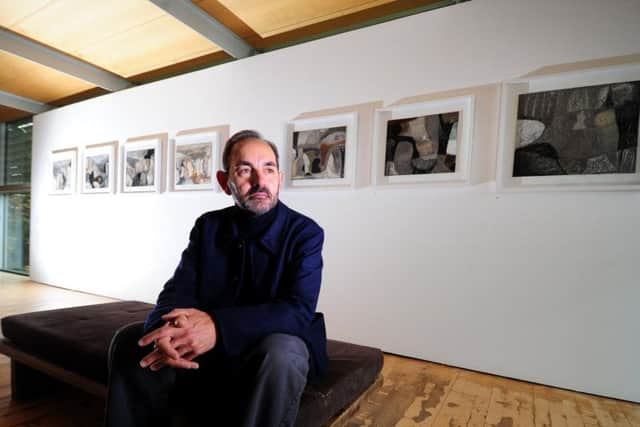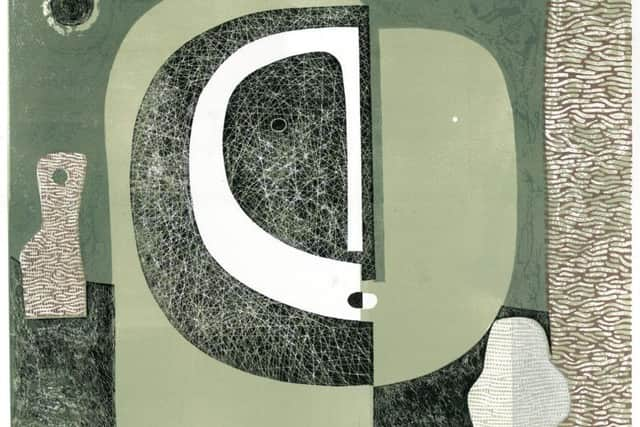Melvyn Evans’s work is the focus of an exhibition at Yorkshire Sculpture Park - we talk to the illustrator and printmaker
Imprinting the Land features original drawings, paintings and lino prints – all of which are for sale – by artist, illustrator and printmaker Melvyn Evans whose work references our relationship to the land and the sea. His bold, brightly coloured linocut prints transport the viewer to picturesque coastal villages and remote rural places, highlighting the largely unchanged centuries-old traditions of fishing and farming. Many of the pictures include landmarks, waymarkers or monuments evoking a strong sense of place.
“Most people love being out in the landscape or viewing it,” says Evans. “And one of the things I’ve always been interested in is the idea of the marks we leave in the landscape going back for millennia and how we can read those. We have a kind of collective unconscious memory that generations have handed down. Although we often don’t know the meanings of those marks anymore, we realise their significance. They are mysterious but we seem to connect with that mystery somehow. All of that feeds in to my work.”
Advertisement
Hide AdAdvertisement
Hide AdBuddy Brook - the Yorkshire artist carving sustainable works out of woodA series of prints, including Stone Forest (2019) and Lost Land (2019), which feature in the exhibition, depict the fossilised ruins of the submerged causeway Doggerland – an area of land, now beneath the North Sea, that connected Britain to continental Europe. It can still be seen, when the tide is out, in some areas of the country, particularly from the beach at Redcar in North Yorkshire. “The area of Doggerland was flooded about 6,000 years ago and we can see remnants of that at low tide – fossilised trees and so on appear that used to be part of the landscape. Another thing I explore in my work is this idea that there have been traumatic changes to the landscape.


“Now they are building a lot of wind farms in that part of the sea and gaining an understanding of how and why the flooding happened. It is quite ironic that on the one hand we are learning about how climate change has affected us in the past and on the other we are still making irreversible changes to the landscape. In the past our lives were dictated to by the landscape and it seemed very stable, but now we are realising how fragile it is.”
Meet the artists putting Wakefield’s cultural scene on the mapWhen Evans was invited to exhibit at the YSP, he visited a few times spending time in the park walking and sketching. “It was wonderful to see the juxtaposition of sculpture in that beautiful landscape,” he says. “I particularly liked Barbara Hepworth’s The Family of Man and it connects with the ideas that interest me. The figures in the sculpture are people, a family, but they also signify mankind and are, in a way, remnants of the past. It is such a lovely sculpture. When you look up at it from below it has quite a significance, and I like the textures and the colouring Hepworth used – the dark against the white and the bronzes and the holes, seeing the landscape through those circular windows.” Out of the sketches he made of Hepworth’s iconic piece, Evans has created an exclusive YSP limited edition print which echoes the textured finish of the sculptures.
In fact, sculpture has been an inspiration in Evans’s work more generally – and it can be seen in his oil paintings, in particular, upon which you can see markings he has etched. “I love sculpture and seeing the marks on the surface,” he says. “I applied that principle to my paintings – I wanted them to be objects as well as being 2D and for them to have that patina on them, like layers of carvings that have been worn back.” The paintings are very striking and have a feeling of long history about them – almost like primitive folk art.
Advertisement
Hide AdAdvertisement
Hide AdThe Great Wave off Kanagawa by Japanese artist Hokusai displayed at RHS Garden Harlow Carr in HarrogateAnother key theme in Evans’s work is the sea and the coast, an influence which stems back to his childhood. “When I was growing up, as a family we always lived near the coast. My father was in the Navy so we moved from port to port. When he left the Navy he bought a hill farm in West Wales and I spent a lot of time working on the farm; you get to know the land really well.”


Evans had an unusual route into printmaking and illustration, having trained as a marine engineer and worked as a submariner before going on to study at Exeter College of Art and Design, Goldsmiths and the Royal College of Art. “I did a five-year apprenticeship at Portsmouth dockyard and then spent 18 months working on submarines. I left as soon as the opportunity arose, but looking back now I think all the engineering experience has fed into my print-making. I like problem solving and experimenting, using the presses in different ways to create unusual marks.”
Melvyn Evans: Imprinting the Land is at the Yorkshire Sculpture Park until February 23. Evans will be leading a Lino Printing workshop on February 15, 10am-4pm. Details and to book www.ysp.org.uk